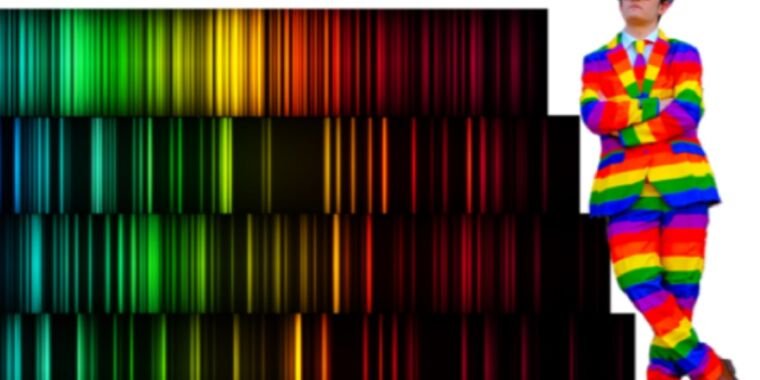Elemental music: Interactive periodic table turns He, Fe, Ca into Do, Re, Mi
[ad_1]

W. Walker Smith and Alain Barker
We’re all familiar with the elements of the periodic table, but have you ever wondered what hydrogen or zinc, for example, might sound like? W. Walker Smith, now a graduate student at Indiana University, combined his twin passions of chemistry and music to create what he calls a new audio-visual instrument to communicate the concepts of chemical spectroscopy.
Smith presented his data sonification project—which essentially transforms the visible spectra of the elements of the periodic table into sound—at a meeting of the American Chemical Society being held this week in Indianapolis, Indiana. Smith even featured audio clips of some of the elements, along with “compositions” featuring larger molecules, during a performance of his “The Sound of Molecules” show.
As an undergraduate, “I [earned] a dual degree in music composition and chemistry, so I was always looking for a way to turn my chemistry research into music,” Smith said during a media briefing. “Eventually, I stumbled across the visible spectra of the elements and I was overwhelmed by how beautiful and different they all look. I thought it would be really cool to turn those visible spectra, those beautiful images, into sound.”
What do the elements sound like?
Data sonification is not a new concept. For instance, in 2018, scientists transformed NASA’s image of Mars rover Opportunity on its 5,000th sunrise on Mars into music. The particle physics data used to discover the Higgs boson, the echoes of a black hole as it devoured a star, and magnetometer readings from the Voyager mission have also been transposed into music. And several years ago, a project called LHCSound built a library of the “sounds” of a top quark jet and the Higgs boson, among others. The project hoped to develop sonification as a technique for analyzing the data from particle collisions so that physicists could “detect” subatomic particles by ear.
Markus Buehler’s MIT lab famously mapped the molecular structure of proteins in spider silk threads onto musical theory to produce the “sound” of silk in hopes of establishing a radical new way to create designer proteins. The hierarchical elements of music composition (pitch, range, dynamics, tempo) are analogous to the hierarchical elements of protein structure. The lab even devised a way for humans to “enter” a 3D spider web and explore its structure both visually and aurally via a virtual reality setup. The ultimate aim is to learn to create similar synthetic spiderwebs and other structures that mimic the spider’s process.
Several years later, Buehler’s lab came up with an even more advanced system of making music out of a protein structure by computing the unique fingerprints of all the different secondary structures of proteins to make them audible via transposition—and then converting it back to create novel proteins never before seen in nature. The team also developed a free Android app called the Amino Acid Synthesizer so users could create their own protein “compositions” from the sounds of amino acids.
So Smith is in good company with his interactive periodic table project. All the elements release distinct wavelengths of light, depending on their electron energy levels, when stimulated by electricity or heat, and those chemical “fingerprints” make up the visible spectra at the heart of chemical spectroscopy. Smith translated those different frequencies of light into different pitches or musical notes using an instrument called the Light Soundinator 3000, scaling down those frequencies to be within the range of human hearing. He professed amazement at the sheer variety of sounds.
“Red light has the lowest frequency in the visible range, so it sounds like a lower musical pitch than violet,” said Smith, demonstrating on a toy color-coded xylophone. “If we move from red all the way up to violet, the frequency of the light keeps getting higher, and so does the frequency of the sound. Violet is almost double the frequency of red light, so it actually sounds close to a musical octave.” And while simpler spectra like hydrogen and helium, which only have a few lines in their spectra, sound like “vaguely musical” chords, elements with more complex spectra consisting of thousands of lines are dense and noisy, often sounding like “a cheesy horror movie effect,” according to Smith.
His favorites: helium and zinc. “If you listen to the frequencies [of helium] one by one instead of all at once, you get an interesting scale pattern that I have used to make a couple of compositions, including a ‘helium dance party,'” said Smith. As for zinc, “The first row of transition metals have very complex, dense grating sounds. But zinc, for whatever reason, despite having a large number of frequencies, sounds like an angelic vocalist singing with vibrato.”
Smith is currently collaborating with the Wonder Lab Museum in Bloomington, Indiana, to develop a museum exhibit that would enable visitors to interact with the periodic table, listen to the laments, and make their own musical compositions from the various sounds. “The main thing I want to [convey] is that science and the arts aren’t so different after all,” he said. “Combining them can lead to new research questions, but also new ways to communicate and reach larger audiences.”
[ad_2]
Source link




